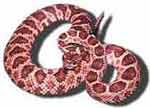United States Snake ID by State | |
| Western Rattle Snake | |
Snake Identification Question:
"I found a snake in my yard today. It is brown with a lighter colored belly. I think it has bands or stripes on it. What kind of snake is it? How do I go about identifying this snake? I don't have a picture to send."
I get snake identification questions like this one on a weekly basis. But they are not questions that I can answer with any certainty, especially in the absence of photos. Identifying a snake from a general verbal description is hard, because there often many species in the same region that have similar markings.So I got to thinking, maybe I would create a snake ID section of the website with photos of snake species across the United States, to help people in identifying snakes in their area.
But then I thought better of it — that's a lot of work, and why reinvent the wheel? There are plenty of snake identification websites already, and many of them are created for specific states across the U.S. So instead of trying to do what has already been done, I thought I would compile many of these excellent resources in one place.
Snake ID Chart - Organized by States in the U.S.
Here is the result of my research. I give you the Snake Identification Chart for states across the U.S. Just click on your state from the table below, and you will be presented with links to helpful websites about snakes in your area. It's a snake ID wonderland!| Alabama Alaska (none) Arizona Arkansas California Colorado Connecticut (PDF) Delaware Florida Georgia |
Hawaii Idaho Illinois Indiana Iowa (bottom) Kansas Kentucky Louisiana Maine Maryland |
Massachusetts Michigan Minnesota Mississippi Missouri Montana Nebraska Nevada New Hampshire New Jersey |
New Mexico (PDF) New York North Carolina North Dakota Ohio Oklahoma Oregon Pennsylvania Rhode Island (PDF) South Carolina |
South Dakota Tennessee (PDF) Texas Utah Vermont Virginia Washington State West Virginia Wisconsin Wyoming |
Identifying Snakes From a Distance
In closing, let me offer a word of advice. Don't ever try to look at a snake up close, unless you are certain what species it is. Many of you probably think this is a no-brainier, but you would be surprised how many venomous snake bites take place because the person thought it was a non-venomous species. Identifying snakes from a safe distance is the ideal way to do it. In this context, a "safe distance" is a distance longer than the length of the snake. In other words, stay at least seven feet away from a six-foot-long snake.Venomous Snakes by State
This section is a work in progress, and will be for many weeks. We are trying to compile information about venomous snakes for all states within the U.S.North Carolina
I hope you find this snake identification resource helpful.

No comments:
Post a Comment
Do To the enormous amounts of spam I will no longer take the time to moderate Anyone posting under anonymous... Sorry for the inconvenience but my email is blasted everyday with 40 to 50 anonymous posts that are junk mail. I just don't have the time to read each one before deleting.